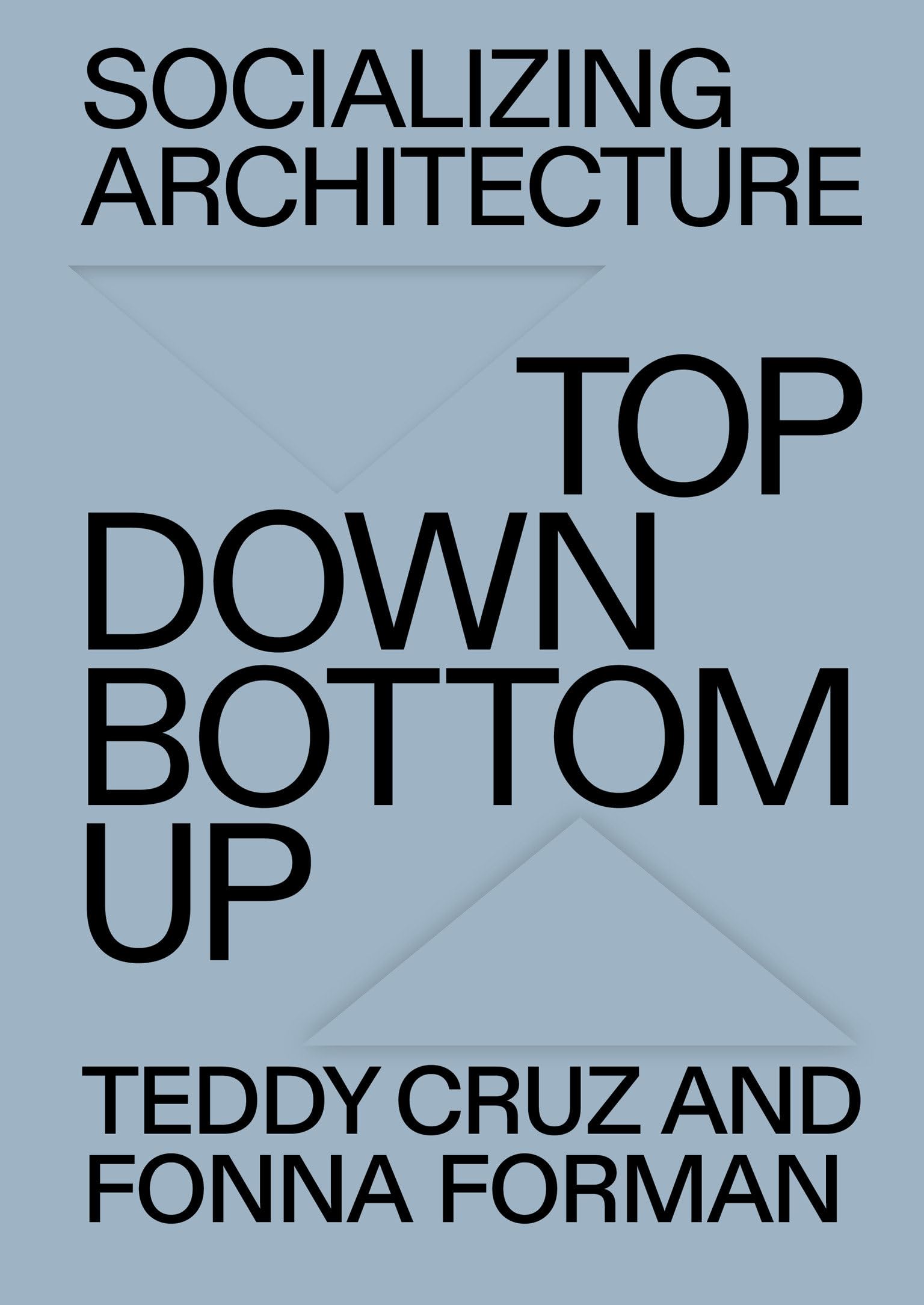REVIEW BY: EMILIE TAYLOR WELTY

May 30, 2025
At a time when national and international news deliver an endless stream of environmental, social, and political calamity, architects and educators may struggle to respond in meaningful and effective ways. Socializing Architecture: Top Down Bottom Up by Teddy Cruz and Fonna Forman offers one approach, engaging local projects to address global issues and imagine more equitable futures. As the title indicates, the book positions the studio’s work as a mediator between the bottom-up emergent strategies of informal urbanization and the top-down approach of governments and institutions. While this is not a new concept for community-engaged design and design-build practices, the multidisciplinary place-based spatial justice work brought into focus by Cruz and Forman is noteworthy.
Socializing Architecture is the second in a two-volume series by Cruz and Forman, following Spatializing Justice: Building Blocks (MIT Press, 2022). These two books feature provocations and proposals advancing social and spatial justice, rooted in projects on the US-Mexico border. The contested border spaces of the Tijuana-San Diego region situate the many scales and modes of design research and practice for Estudio Teddy Cruz + Fonna Forman. Through essays and project examples, Cruz and Forman bridge grassroots strategies with top-down policy makers to create change.
Socializing Architecture is structured in two main parts: essays and project clusters. Essays ground the work in the layered complexities of the border zone. They frame the design investigations while challenging professionals and academics to recognize the social, political, and ethical impact of this work and to take a stand against inequality, climate change, and injustice in its many forms. The five essays press the reader to see the global in the local, the political dynamics of projects, and the opportunities embedded in cocreating and imagining new futures. The authors advocate for civic practices to embrace an incremental approach to change built through dialogue and productive conflict. This would entail engaging people across ideological spectrums to create a more just city.
The second section of the book offers a wide range of examples depicting the practical realities of this call to arms in the context where Cruz and Forman work. The projects, grouped into six thematic clusters, make up the majority of the book and are a testament to the last ten years of interdisciplinary research and design work by the studio. This section also attends to the visual bias of the book’s audience—designers, architects, and urbanists who best understand the intersection of theory and practice through project examples. The book’s thematic clusters include various strategies for spatializing justice by working across scales and disciplines. Throughout, the mapping of conflicts, participatory design practices, adaptations of informal approaches, and progressive governance structures are some of the tools used to understand the social, economic, and political complexities of a given project. Particularly interesting from a wider public engagement standpoint are those projects which venture into tactical urbanism and design-build territories. In many projects, common objects are employed in uncommon ways – as in a spiky grid of traffic cones cladding a temporary pavilion, or industrial shelving components reimagined as migrant housing frameworks. This work exhibits sensitivity to the role and value of labor, the economics of design, and construction processes.
Reading these provocations, I am reminded of the radical shift in practice that was embedded in the early work of community design groups such as the Architects Renewal Committee of Harlem or Karl Linn’s Neighborhood Commons project. Equally embedded in these projects are the long ripples of Henry Sannoff’s community participation work, including university-based design centers such as the Detroit Collaborative Design Center and Tulane’s Small Center for Collaborative Design. Furthermore, some of the social and cross-border themes in the design-build work pull from histories of the travels/travesias and radical pedagogical projects of the Pontifical Catholic University of Valparaíso (Chile) in the 1960s and 70s. Cruz and Forman’s work builds upon these lineages, while also offering a nuanced and empathetic response to the current political rhetoric about tariffs, immigration, and inequality. Here the authors expand the scope of design and its impacts by visualizing conflict and acting to translate, facilitate, and mediate between larger urban research and smaller tangible interventions.
In the essays and project descriptions, the book underscores the value of “knowledge cocreation” and “coproduction” with partners, a best practice in community design and Public Interest Design circles. This illuminates a potential oversight of the book: the inclusion of the perspectives of cocreators (community groups, partners, students and the public program participants). While the work of Estudio Teddy Cruz + Fonna Forman is highly visible in design circles, the volume could reflect more deeply on the communities that ground their work. Interdisciplinary and multimodal practice can make outcomes hard to track, but the voices of partners and participants offer a more comprehensive perspective of design processes, outcomes, and impacts.
As the efforts of community-engaged and justice-oriented practices continue to gain prominence, Estudio Teddy Cruz + Fonna Forman exhibit their own productive approaches for working across literal national boundaries and the conceptual gulf between academia and practice. And while Cruz and Forman work in a highly charged locality, their words and work require readers to consider how their own local projects and teaching engages in these topics. They challenge us to collaborate with others, work to understand broader complexities, and then to roll up our sleeves and get to work.
Emilie Taylor Welty is an architect and associate professor of architecture at the Tulane School of Architecture where she also serves as the director of the architecture program. She is a leader in design-build education and works with Small Center, Tulane’s community design center, to expand access to design in New Orleans. Her upcoming book, published by Routledge, is titled Design Build Pedagogies for Social Change: Past, Present, and Potentials. She also runs a practice with Seth Welty called Colectivo.






